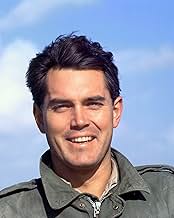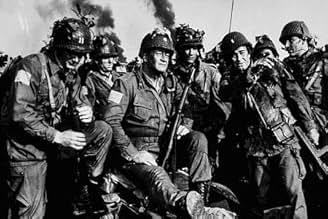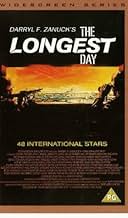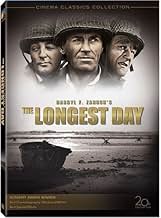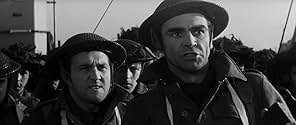Die Ereignisse des D-Day, die in großem Stil sowohl aus alliierter als auch aus deutscher Sicht erzählt wurden.Die Ereignisse des D-Day, die in großem Stil sowohl aus alliierter als auch aus deutscher Sicht erzählt wurden.Die Ereignisse des D-Day, die in großem Stil sowohl aus alliierter als auch aus deutscher Sicht erzählt wurden.
- 2 Oscars gewonnen
- 8 Gewinne & 6 Nominierungen insgesamt
Irina Demick
- Janine Boitard
- (as Irina Demich)
Empfohlene Bewertungen
The Longest Day works on several levels - the most obvious being the "don't blink or you might miss several" nature of the Star-Studded cast. Much of the cast works very well (Sean Connery's little comedy double act with Norman Rossington is an unexpected highlight). Some less so, and some is just downright tokenism - Rod Steiger getting all of 43 seconds on-screen for example. But overall, it's always a watchable movie - beautifully shot.
Some previous comment have surprised me, particularly the assertion that The Longest Day is, in any way, a "pro-war" film. I'm not sure if there *is* such a thing, but if there is then The LOngest Day certainly doesn't fall into this category - the scene of bewilderment between Richard Burton and Richard Beymer at the end about the confusion and directionlessness of war is the perfect example, ending with the memorable line "I wonder who won".
I'm also surprised that a European reviewer should have accused this film, of all world war II movies, of being American propoganda. I wonder how many other WWII films include both German and (almost unqiuely) French perspectives of the war to such an extent that almost half of the dialogue in them is in a language other than English. I find the German sequences in The Longest Day to be amongst the most interesting historically and dramatically.
The film is certainly as accurate as it's possible for a fictional movie to be - the list of advisors that it had working on it should prove that - including many people who are portrayed by actors in the movie itself. These include the characters played by Peter Lawford, Richard Todd and Kenneth More, along with several of the German field officers. Little touches that seem utterly out of place (like the nuns procession through the French village bringing a temporary ceasefire) are actually historically spot-on.
The final problem for the modern reviewer, of course, is the inevitable comparison between this film and Saving Private Ryan. But, as several other contributors have noted, SPR is not only the product of a different age with a different view of these events - historical as opposed to something which happened so recently that half of the audience are likely to have lived through them. But, ultimately, something usually forgotten about Operation Overlord is that Omaha Beach was merely one battle of a very long day indeed. Americans tend to focus on it because of the death toll, but the taking of Utah, Sword and Gold were just as important to the overall outcome. The Longest Day is a film about five beaches, many battles, and many men - some, as Richard Burton says, dead, some crippled and some lost. It is an anti-war film which proves that you can be anti-war and still celebrate and acknowledge heorism. The heroism of the young American and British troops, falling face-first into the salt water of the Normandy killing grounds. The incredible bravery of the Rangers who scaled the cliffs at Pointe du Luc on and, ultimately, meaningless mission. The heroism of the two Luftwaffe pilots commanded to face the invading armies alone, and who did so (another historically accurate point).
The Longest Day is a historic film about a historical event and it should be viewed as such.
9/10
Some previous comment have surprised me, particularly the assertion that The Longest Day is, in any way, a "pro-war" film. I'm not sure if there *is* such a thing, but if there is then The LOngest Day certainly doesn't fall into this category - the scene of bewilderment between Richard Burton and Richard Beymer at the end about the confusion and directionlessness of war is the perfect example, ending with the memorable line "I wonder who won".
I'm also surprised that a European reviewer should have accused this film, of all world war II movies, of being American propoganda. I wonder how many other WWII films include both German and (almost unqiuely) French perspectives of the war to such an extent that almost half of the dialogue in them is in a language other than English. I find the German sequences in The Longest Day to be amongst the most interesting historically and dramatically.
The film is certainly as accurate as it's possible for a fictional movie to be - the list of advisors that it had working on it should prove that - including many people who are portrayed by actors in the movie itself. These include the characters played by Peter Lawford, Richard Todd and Kenneth More, along with several of the German field officers. Little touches that seem utterly out of place (like the nuns procession through the French village bringing a temporary ceasefire) are actually historically spot-on.
The final problem for the modern reviewer, of course, is the inevitable comparison between this film and Saving Private Ryan. But, as several other contributors have noted, SPR is not only the product of a different age with a different view of these events - historical as opposed to something which happened so recently that half of the audience are likely to have lived through them. But, ultimately, something usually forgotten about Operation Overlord is that Omaha Beach was merely one battle of a very long day indeed. Americans tend to focus on it because of the death toll, but the taking of Utah, Sword and Gold were just as important to the overall outcome. The Longest Day is a film about five beaches, many battles, and many men - some, as Richard Burton says, dead, some crippled and some lost. It is an anti-war film which proves that you can be anti-war and still celebrate and acknowledge heorism. The heroism of the young American and British troops, falling face-first into the salt water of the Normandy killing grounds. The incredible bravery of the Rangers who scaled the cliffs at Pointe du Luc on and, ultimately, meaningless mission. The heroism of the two Luftwaffe pilots commanded to face the invading armies alone, and who did so (another historically accurate point).
The Longest Day is a historic film about a historical event and it should be viewed as such.
9/10
Invariably compared with "Saving Private Ryan" (SPR), this scores over the more modern work because of the focus on all the major sides of the action (British, American, French and German).
All languages are used (with subtitles as appropriate - eg the Germans speak in German, etc).
While true that the battle scenes are not gory as SPR's, and that the sounds of battle are muted during the dialog (unlike SPR's), it should be borne in mind that in '62, the audience rating of the time *was* a General Release ("G" in the US, "A" in the UK (I'm guessing for the UK, but it is now PG)) - which more detail would not have allowed.
I think part of the purpose of this film is to allow *everyone* to see what happened 18 years before!
All languages are used (with subtitles as appropriate - eg the Germans speak in German, etc).
While true that the battle scenes are not gory as SPR's, and that the sounds of battle are muted during the dialog (unlike SPR's), it should be borne in mind that in '62, the audience rating of the time *was* a General Release ("G" in the US, "A" in the UK (I'm guessing for the UK, but it is now PG)) - which more detail would not have allowed.
I think part of the purpose of this film is to allow *everyone* to see what happened 18 years before!
This an important, interesting movie depicting the Overlord operation with monumental logistic and means of effecting the Normandy landing , the most difficult campaign of war . The picture brings to life the famous images of WWII and splendidly the most sensational military operation of the history in an Allied hard-fought effort . The film develops the previous days to the D-Day invasion , such as the landings and the advance over France . The film is magnificently produced in big budget by the great 20th Century Fox producer Darryl F. Zanuck . Evocative cinematography by Jean Bourgoun and catching song by Paul Anka with musical score by Maurice Jarre . Excellent casting by a great plethora of stars . Special mention for John Wayne as Lt. Colonel Benjamin Vandervoort , he's top-notch as a tough , valiant officer in this believable war film and terrific acting by Richard Todd as Major commanding Us paratroopers dropped to protect the flanks of the invasion and taking strategic bridge . Furthermore , known Generals and officers played by prestigious players , as Germans : General Gunther (Curt Jurgens) , Field Marshal Erwin Rommel (Hinz) , Field Marshal Von Rundstedt (Paul Hartmann), and Allied : Brig. General Theodore Roosevelt Jr (Henry Fonda) , Brig. General Norman Cota (Robert Mitchum) , General Haines (Mel Ferrer) , Brig. General James Gavin (Robert Ryan) , General Raymond Barton (Edmond O'Brien), Lt General OMar N Bradley (Stuart) , General Bernard L Montgomery (T. Reid) and General Dwight D. Eisenhower played by Henry Grace . Grace was a famed set designer , while he worked extensively for many films , his only appearance was an uncredited performance as Eisenhower ; despite not being an actor , he was cast for his uncanny resemblance to the General . This famous event from how was orchestrated the dangerous , risky landing maneuvers was professionally directed by a magnificent trio of directors , Ken Annakin , Bernhard Wicki and Andrew Marton.
Adding more details along with the well developed on the movie , the events that happened on June 6, 1944 were the following ones : Shortly after midnight on June 6, about 23.500 US and British paratroopers landed along the edges of the landing beaches . Their mission was to seize vital bridges and communications centers. They also had to hold off any Germans counterattacks until they were relieved by the amphibious forces. The Airbone landings were largely successful. Some US troops missed their target and end up scattered over the countryside. The main amphibious landings took place after an artillery bombardment from some 200 Allied warships at German positions also came under attack from Allied medium and heavy bombers. They were part of the 11,500 aircraft committed to D-Day. They bombed the Germans on and behind the five landing beaches. US troops landed on Utah beach. Strong currents and inaccurate navigation meant that they were a little away from their precise target. They landed about 1 mile (1,6 km) south. The beach there was relatively undefended. The troops soon knocked out the only concrete gun position guarding the beach.Demolitions teams cleared paths through the obstacles the beach and the first tanks crossed the Atlantic Wall. They fanned out into the countryside to link up with the paratroopers. By nightfall of D-Day some 23,000 men and 1,700 vehicles had gone ashore. The beach had been highly congested for much of the day. Utah was a triumph ,however Omaha beach was nearly a disaster, the fight was the most difficult. The Us troops were unable to get off the beach to make room for later waves of invaders. There were better defenses there than on the other beaches, and the German defenders were positioned on high ground, from where they could pour fire down on the attackers.The allies also made mistakes. The naval bombardment ended too soon, and the bombers missed their targets and launched landing crafts and amphibious tanks too far out from the beach, may were sunk. When the first assault wave landed ,it faced a bar-rage of fire , some men were thinking of evacuation. However small groups began to make it off the beach to the high ground beyond. By dusk, some men were ashore, most were still crowed on the beach. The high ground beyond was only thinly held by exhausted survivors waves. Some 2300 US troops had been killed in the landings. The operation had come close to disaster. The three Anglo-Canadian beaches-Gold, Sword and Juno stretched fore some 25 miles. They were wide and open and ideal for amphibious landings. The British on Gold and Sword quickly crashed though the Atlantic wall. Their success was due partly to a range of specially developed armored vehicles known as Funnies. The Canadians at Juno had a tougher time. They faced rough seas and alert defenders .By late morning ,they were also pushing inland. Despite the horror of beaches , overall Allied losses were far lower than expected. Some 6000 US personnel were killed, wounded, or missing, along with 4300 British and Canadian troops. German losses totaled between 4000 and 8000. By the day's end ,some 128000 Allied soldiers were ashore and many more were on their way.
Adding more details along with the well developed on the movie , the events that happened on June 6, 1944 were the following ones : Shortly after midnight on June 6, about 23.500 US and British paratroopers landed along the edges of the landing beaches . Their mission was to seize vital bridges and communications centers. They also had to hold off any Germans counterattacks until they were relieved by the amphibious forces. The Airbone landings were largely successful. Some US troops missed their target and end up scattered over the countryside. The main amphibious landings took place after an artillery bombardment from some 200 Allied warships at German positions also came under attack from Allied medium and heavy bombers. They were part of the 11,500 aircraft committed to D-Day. They bombed the Germans on and behind the five landing beaches. US troops landed on Utah beach. Strong currents and inaccurate navigation meant that they were a little away from their precise target. They landed about 1 mile (1,6 km) south. The beach there was relatively undefended. The troops soon knocked out the only concrete gun position guarding the beach.Demolitions teams cleared paths through the obstacles the beach and the first tanks crossed the Atlantic Wall. They fanned out into the countryside to link up with the paratroopers. By nightfall of D-Day some 23,000 men and 1,700 vehicles had gone ashore. The beach had been highly congested for much of the day. Utah was a triumph ,however Omaha beach was nearly a disaster, the fight was the most difficult. The Us troops were unable to get off the beach to make room for later waves of invaders. There were better defenses there than on the other beaches, and the German defenders were positioned on high ground, from where they could pour fire down on the attackers.The allies also made mistakes. The naval bombardment ended too soon, and the bombers missed their targets and launched landing crafts and amphibious tanks too far out from the beach, may were sunk. When the first assault wave landed ,it faced a bar-rage of fire , some men were thinking of evacuation. However small groups began to make it off the beach to the high ground beyond. By dusk, some men were ashore, most were still crowed on the beach. The high ground beyond was only thinly held by exhausted survivors waves. Some 2300 US troops had been killed in the landings. The operation had come close to disaster. The three Anglo-Canadian beaches-Gold, Sword and Juno stretched fore some 25 miles. They were wide and open and ideal for amphibious landings. The British on Gold and Sword quickly crashed though the Atlantic wall. Their success was due partly to a range of specially developed armored vehicles known as Funnies. The Canadians at Juno had a tougher time. They faced rough seas and alert defenders .By late morning ,they were also pushing inland. Despite the horror of beaches , overall Allied losses were far lower than expected. Some 6000 US personnel were killed, wounded, or missing, along with 4300 British and Canadian troops. German losses totaled between 4000 and 8000. By the day's end ,some 128000 Allied soldiers were ashore and many more were on their way.
The Longest Day is one of the greatest war films ever. Bar none. The acting, the cinematography, the storline and the acuraccy are great. if any of you fans watch AMC watch the Backstory behind this movie. It's amazing that it was even made. This is Zanuck's greatest work. The perspective from the different combatants regardless of their rank is great. Like somebody else said it did not portray the Germans as cartoonish evil doers. It gave a good honest portrayal that I wish more war movies would have. As a history buff I love to see movies from other countries soldier perspectives. This captures it better than every other war movie. The only one that comes close is Tora, Tora, Tora. There is one drawback however and that is the rangers at Pointe De Hoc. They did find the big guns but,they were further inland and later destroyed before they could be used. Zanuck used this to show the futility and waste of war. Other than that is a classic with very few flaws. The comparison between SPR and TLD are well like comparing apples and oranges. Yes, SPR has gritty realism that stuns you, but like another reviewer said, this was 1962 and the movie was about the entire scope of the battle. It was not meant to be up close and personal like SPR. Many of us appreciate movies from different perspctives. This is not a movie you should not rent. You should own it as part of your video collection. This movie may appear to be pro-war and patriotic, but Zanuck himself said he wanted to make an anti-war film. I think he did so magnificantly. He captured the essence of the book where Cornelius Ryan said he wrote about the men,not the battles. That is why Zanucks film is so successful. He captured the men and their feelings, whether they were American, British,German's or French and what they were feeling going into one WW2's most decisive battle. This is a Four Star Classic!!!!
This was an another one of these all-star casts that you don't see in more modern times, in which about everyone who was actor made an appearance....or it just seems that way. For those unfamiliar with this film, take a look back on the main page here and check out the famous names in this movie. Click the "more" under the cast overview and you'll see all the names. It's unbelievable. Some of them, to be fair, had very short roles in here, such as Henry Fonda, Rod Steiger and Roddy McDowell, but this is a real "Who's Who" of the acting profession in 1962. There are also a lot of German actors in here speaking German (with subtitles provided), perhaps numbering even more than the English-speaking stars. That's because the famous day of June 6, 1944, is seen from both sides of the conflict.
At three hours, it gives you plenty of D-Day World War II action. Almost two-thirds of the movie involves action from that famous invasion. In some spots, it just gets to be too much. Frankly, the whole film is too much and almost bogs down in too many areas....and it shouldn't, but it is a very technical film. And, for a film 45 years old, the action is pretty realistic. I thought the best shots were the overheads during one particular scenes when the Alies were going through a town.
I am anything but a WWII expert so how much detail of the infamous 'D-Day" here is correct, Since they went into such detail, I'll assume they were fairly accurate. I can't say but this movie educated me on the size of the task. I had no idea "D-Day" was this huge in scope: three million men and 5,000 ships??!!! Amazing.
At three hours, it gives you plenty of D-Day World War II action. Almost two-thirds of the movie involves action from that famous invasion. In some spots, it just gets to be too much. Frankly, the whole film is too much and almost bogs down in too many areas....and it shouldn't, but it is a very technical film. And, for a film 45 years old, the action is pretty realistic. I thought the best shots were the overheads during one particular scenes when the Alies were going through a town.
I am anything but a WWII expert so how much detail of the infamous 'D-Day" here is correct, Since they went into such detail, I'll assume they were fairly accurate. I can't say but this movie educated me on the size of the task. I had no idea "D-Day" was this huge in scope: three million men and 5,000 ships??!!! Amazing.
Wusstest du schon
- WissenswertesWhile clearing a section of the Normandy beach near Pointe du Hoc, the crew unearthed a tank that had been buried in the sand since the original invasion. Mechanics cleaned it off, fixed it up and it was used in the movie as part of the British tank regiment.
- PatzerA compound fracture of the ankle indicates blood and/or protruding bones, of which Vandervoort's ankle had none. It also would have been impossible to put any weight on the ankle.
- Zitate
Flight Officer David Campbell: The thing that's always worried me about being one of the few is the way we keep on getting fewer.
- Crazy CreditsThere is a 20-second overture on a black screen, no 20th Century Fox logo (in spite of this being one of their most expensive productions), and a six-minute cold open before the title is displayed. Apart from the title, there are no credits at the beginning of the film. All cast and crew credits are at the end of the film.
- Alternative VersionenSome video copies omits Jean Servais scenes as a Free French admiral making a short speech to his crew before the shore bombardments starts.
- VerbindungenEdited into All This and World War II (1976)
Top-Auswahl
Melde dich zum Bewerten an und greife auf die Watchlist für personalisierte Empfehlungen zu.
Details
- Erscheinungsdatum
- Herkunftsland
- Offizieller Standort
- Sprachen
- Auch bekannt als
- El día más largo del siglo
- Drehorte
- Sainte-Mère-Eglise, Manche, Frankreich(parachutists landing in the village)
- Produktionsfirma
- Weitere beteiligte Unternehmen bei IMDbPro anzeigen
Box Office
- Budget
- 10.000.000 $ (geschätzt)
- Laufzeit2 Stunden 58 Minuten
- Farbe
- Black and White(original version)
- Seitenverhältnis
- 2.35 : 1
Zu dieser Seite beitragen
Bearbeitung vorschlagen oder fehlenden Inhalt hinzufügen




